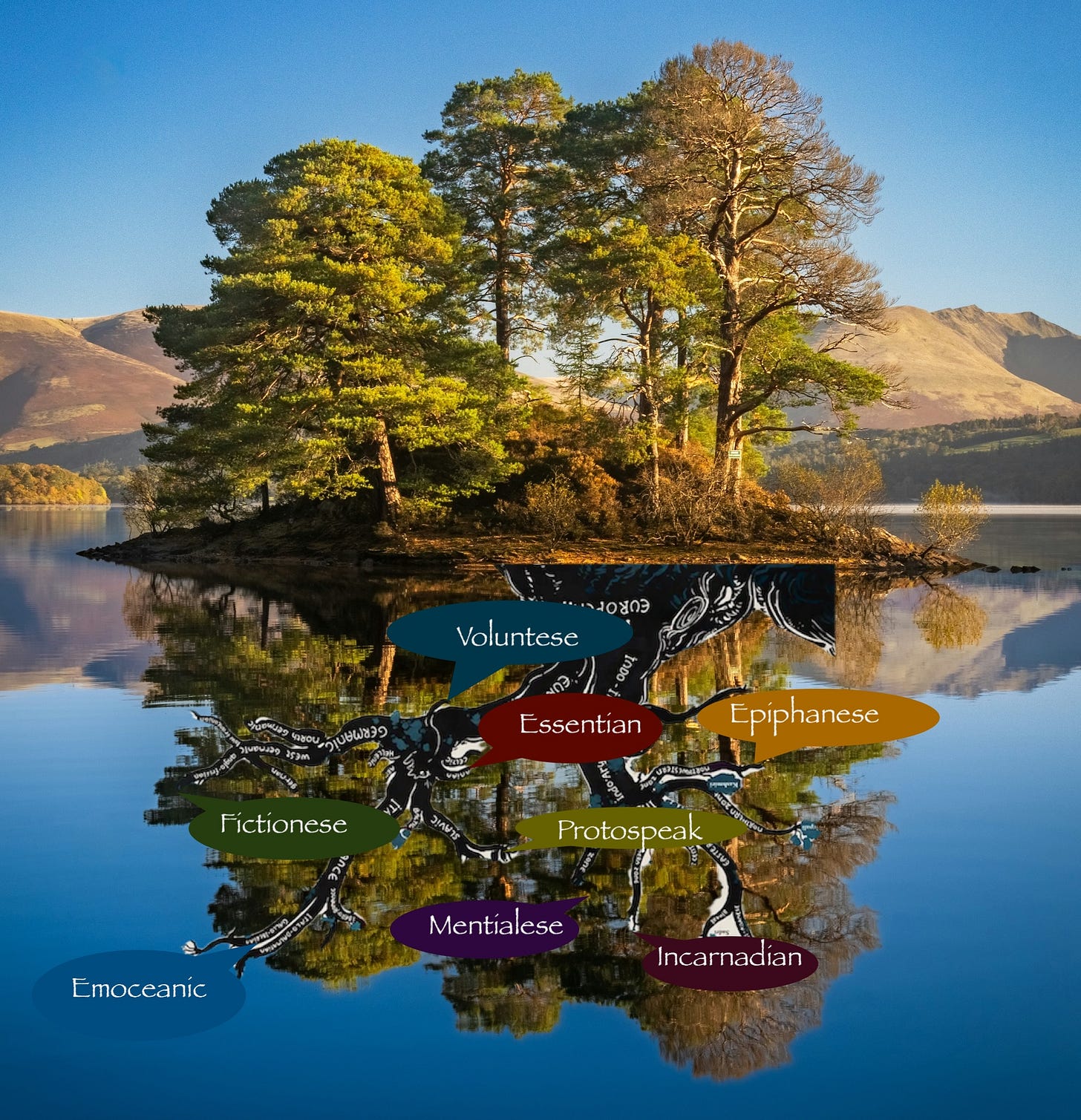There are some things, however,
that we cannot fathom by thinking about them,
but only by experience.
〰 Michael Ende 〰
Learning to Read Your Own Mind
You can’t depend on your eyes
when your imagination is out of focus.
〰 Mark Twain 〰
Diving through a wave of emotional turmoil doesn’t permanently release immature creatures from the inner permafrost. Or, looking at it from the opposite perspective, if the emotional-wave-experience is sufficient to resolve a situation, the event is unlikely to have triggered unprocessed trauma. Perhaps it’s just a direct and healthy response to an insult (in medical language = an event which causes damage to tissues or organs).
Listening to your Inner Healer, responding to her signals of agitation, is always beneficial. Any loving attention given to our emotional pain sends a warm and comforting message through the entire inner mindscape. A compassionate attitude reverberates not only in the realm of the Instinct. It pervades the whole organism of human Consciousness, shifting the atmosphere from distress towards relief.
As the hosts of our own Consciousness, we are entrusted with the role of hierophant [from Greek hieros = sacred + phanein = to show, bring to light] ~ the initiate who interprets the sacred mysteries ~ of our symbiosphere by default. The question is not whether we accept this role or not. The key to the mystery is hidden within our own willingness to engage in the process of experiencing.
To resolve deep-seated suffering, the initiate is called to study and decipher the inner languages. Like an archeologist, decoding ancient signs scratched into a cave wall or pillar of stone, we don’t need to make sense of the glyphs and characters on the rock face. We start by looking at those signs within their own context ~ temporal, cultural, social, historical, geographical etc.
Every population within each of the Spheres of Reality governed by one of the vital Faculties of human Consciousness speaks a different language, embedded in its own culture. Here is an overview of the 8 Inner Languages within their cultural and territorial contexts:
In the Sphere of Incarnal Reality, the realm of the Inner Ally (Body as a vital Faculty) you meet the Incarnifolk who communicate in Incarnadian (= acting, behaving, doing, encountering in the material realm, happening, having, interacting at the physical level, owning, physical sensing, physiological functioning and their pathological aberrations, reacting, transacting)
Mential Reality, the territory of the Inner Expert (Intellect), is inhabited by the Epimetheans who speak Mentialese (= assuming, drawing rational conclusions, evaluating, pigeonholing, processing logically through rational thoughts, speculating, thinking, theorising)
Inner Ocean Reality, the Sphere of the Inner Healer (Instinct), is buzzing with Harmonites, all fluent in Emoceanic (= feeling, emoting, emotional suffering, sensing and expressing the whole range of emotional excitement and agitation from joy to despair and passion to apathy)
In the realm of Fictional Reality, ruled by the Inner Artist (Imagination), you’ll meet the Phantasians whose mother tongue is Fictionese (= dreaming, envisioning, imagining, imitating, making up stories, pretending, processing through inner images, projecting, simulating, visualising)
First-Notion Reality is the home of the Pronoians, governed by the Inner Guardian (Intuition). Their native language is Protospeak (= believing, doubting, trusting; picking up ‘gut-feelings’, hunches, inklings, notions; harbouring faith, loyalty, skepticism, superstition)
The region called Potential Reality is the sovereign territory of the Inner Genius (Inspiration), and natural habitat of the Dæmonites. This clan communicates in Epiphanese, the language of curiosity and wonder (= discovering, enquiring, exploring, finding, inventing, questioning, researching, searching and seeking; receiving insights, Aha moments, epiphanies, and Eureka experiences)
Crossing the border from the land of wonders and inventions we step into Hierokhôra Reality [from Greek hieros + khôra = the space that is a place for being] , the dominion of the Inner Sovereign (Soul), where the native tongue is Essentian (= the language of being, belonging, becoming, and yearning; contemplating, communicating with nature, listening into silence, meditating; and speaking in symbols)
The ‘final frontier’ of this inner landscape takes us into Volitional Reality, home of the Inner Wizard (Will) and the entire population of Voluntians whose native idiom is called Voluntese (= coveting, desiring, intending, wanting, willing, wishing; agreeing, allowing, approving, assenting, authorising, complying, consenting, expressing willingness, surrendering, yielding; bequeathing)
Awakening the Inner Languages
The most important thing in communication
is hearing what isn’t said.
〰 Peter Drucker 〰
Human Consciousness speaks many languages. We can use words as carriers for these languages in our native or foreign tongues, but our Faculties also communicate in their own indigenous vernacular.
Think for example of body language. At the funeral of former US president Jimmy Carter, commentators were captivated by the body language of interactions between living members of the exclusive US-president-club and their spouses.
What people refer to when using the term ‘body-language’ is only a minuscule portion of the vast vocabulary of the body. Our physical organism is talking to us all the time. This body of non-verbal expressions includes sensations of temperature, balance, atmospheres, distances in space, comfortzone, boundaries, and of course all the information we receive and process via the five senses of vision, hearing, taste, smell, and touch.
And there is more. Our Inner Ally informs us of physiological functions: breathing, pulse rate, neurological responses, muscle activity, the positions of our skeleton and flexibility or stiffness of joints, a full bladder or colon. The Inner Ally can also produce sweat, tears or trembling in response to distress, apprehension, and sexual arousal, and a sense of relief, or visceral flutters reacting to eustress (= good stress due to feeling happy, accomplished, or excited).
This vital Faculty we call Body has a myriad of skills too, which enable her to fulfill all our voluntary physical actions (which we take for granted as long as they function without hickups).
Anything you do is an expression of your Inner Ally. Acting, behaving, reacting are ‘body language’ in this broader sense. It also includes everything that happens to you in the physical realm. In the map of the Noctarine, this language is called Incarnadian, (see the list above). What applies to the physical Faculty of human Consciousness is also true for all the other vital organs.
The thought of having to juggle so many languages may feel overwhelming, especially if you believe that you’re ‘no good at languages’. Don’t worry! Every human has a natural talent at expressing themselves in multiple ways. We do so all the time without noticing.
Language is far more than the words and sentence structures we use. Language is a way of articulating human experience and communicating these experiences with others. All creative forms of expression are languages::: acting, composing, cooking, dancing, designing, drawing, gardening, painting, performing, playing an instrument, reciting, sculpting, singing, weaving, woodcarving, writing…
And within each discipline you’ll find many sublanguages ~ writing poetry, prose, memoir, narrative non-fiction, philosophical essays, romantic novels…
Scanning these lists, you may realise that you already speak quite a few languages in this wider sense fluently. The Inner Languages of human Consciousness are to be understood in this wider sense.
Although every human has access to these forms of expression and communication by default, they are surprisingly little known, It is as if we take them so much for granted that we don’t even bother listening. We are swimming in this ocean of languages like fish who have never heard of the concept of water.
The Difference between Manipulating and Translating
… trying to rope a big wild pig with a shoestring and a toilet seat…
〰 Martín Prechtel 〰
Translating basically means to reword something that has been written or spoken in one language through the vocabulary, sentence structures, and cultural sensibilities of another native tongue.
For example, if you want to translate a message from the Inner Healer, communicated in the language of Emoceanic, into Fictionese, you could capture the emotional turmoil in an abstract picture. Or you could write a fairytale, or a poem, using appropriate metaphors. This translation tool is used in painting, creative writing, and all other art forms all the time.
Before moving into some examples of experiential translations of inner languages, let’s take a look at how emotional messages are currently often ‘translated’ in popular psychology and self-help literature. A favourite theme used by authors to illustrate ‘how to handle negative emotions’ is road rage.
The protagonist gets cut off in traffic, the incident pushes his emotional buttons, and he flies into a rage. A predictable solution offered by authors in such an incident is the recommendation to ‘see the bigger picture’: Imagine the driver who has cut you off in traffic just received a phone call telling him that his wife had an accident, and now the poor fellow is rushing to the hospital.
This imaginary scenario is supposed to instantly shift your negative emotions by engendering empathy for the other driver who is potentially experiencing far greater distress than your own. Of course, this strategy can be effective in the short term. No matter whether the fictional story of the ‘poor driver in distress over his poor wife’ is true or not, it does have an immediate ‘calming effect’ on the road-raging protagonist. But is it really a constructive solution to their emotional outburst?
The drawback with this approach, sold as a clever hack to ‘instantly cure negative emotions’ is that it belongs to the same category as the ‘think of the poor children in Africa’ argument. It comes from the same supremacist mindset. It doesn’t encourage or enable us to tune in and listen to our own emotional messages. It offers no support to help us become more compassionate towards ourselves. Zero!
The implication in this recommended emotional hack is that we should bypass our negative emotions altogether, and that this is a good thing. Now imagine your Inner Healer having an outburst of rage, and you cut her short by telling her some imaginary story as a distraction. How do you think she’ll feel about this?
Here is what my Inner Healer is telling me. If she experienced a moment of being very upset, and I responded by telling her such a story, she would instantly withdraw and go quiet. She would feel embarrassed. She doesn’t want to cause any hassle. (My Inner Healer is a highly sensitive creature, and I assume yours might be too. Mine is also an introvert. Yours might be an extrovert).
By the same stroke of emotional deafness, my response to her causes her to feel miserable, ignored, not taken seriously, swept aside as unimportant, treated with a condescending attitude, disrespected…
The trouble with my attempt to distract her from her own emotions, is that I am effectively telling her (and thereby myself) that other people’s feelings and potential assumed problems are far more important than my own. I am signalling to her that I have no interest in what’s going on in her part of the inner world ~ which happens to be my own.
The fictitious story of the ‘poor other driver who is probably having a tough time’ is not a translation of my own anger or frustration. It is a random narrative, picked out of thin air by some rational speculation. The Inner Expert is instructed by an external source (the authors of such books) to manipulate the behaviour of the Inner Healer. The rationale behind the whole manœuvre is that negative emotions in general are regarded as insignificant, a nuisance which needs to be kept in check by the ‘sensible reasoning part of the mind’.
This is patronising and inconsiderate, the exact opposite of kind and compassionate. Every time we use any manipulative strategy towards ourselves, we are reinforcing the message that our own feelings are unimportant. And how we treat our feelings is how we treat ourselves, which intensifies how we feel about ourselves. It becomes a vicious cycle.
The Power of Translating
Translation takes place at the core of languages.
〰 Luca Illetterati 〰
A genuine translation of emotional messages is empowering. It can shift not only how you feel inside and about yourself. It can dissolve conflicts in social interactions, transform relationships with family members, neighbours or colleagues, and most importantly, it enables you to harness the powers of your own inner demons, instead of trying to dodge them.
In the download attached to this chapter I share an exercise called Feeding your Demons. It is a meditation/visualisation exercise based on an ancient Buddhist meditation known as Chöd practice. The knowledge was brought to Western attention by Lama Tsultrim Allione, an American Buddhist nun who lived and trained in a monastery in Tibet for a number of years.
In her book with the same title Feeding Your Demons, Lama Tsultrim shares a personal experience where she needed to resolve an unsettling disagreement with her former husband. The marriage had fallen apart, the family was living in Italy, she wanted to return to America with the baby. He told her she was ‘free to leave’. Meanwhile he was also struggling with depression and addiction and insisted that the child should stay with him.
In the midst of this deadlock with her husband in the custody battle over the child, Allione used her emotional dilemma as a starting point for a ‘Feeding your Demons’ session in the hope to dissolve the conflict and reach an amicable agreement.
The following day her husband called to tell her that she was genuinely free to return to America with the child. The discord resolved itself without any actions taken at the physical level.
How is that even possible? What is the magic ingredient sprinkled into such a ‘meditation’?
Many years before I came across the Chöd practice and the author’s personal story, I had parallel experiences with my now ex-husband. I used visualisation techniques I’d learned in my training in psychosynthesis. The results were strikingly similar to Allione’s story.
In this practice, the only ‘dispute’ towards resolving a conflict takes place in the mind of the practitioner. No attempts are made to convince the adversary, no pleading, debating, or fighting needs to take place between disagreeing parties. (Not to mention expensive and exhausting lawsuits). It sounds unbelievable, I know. But having experienced it more than once, I know it is true!
In these cases, the communication which leads to a ‘miraculous’ solution of a conflict between two people, which appears to play out in physical reality, takes place between the Inner Healer and the Inner Artist in the mind of one single person involved in the conflict. The other party doesn’t need to be consulted, or informed of the action of their ‘opponent’ to arrive at a consensus.
When we don’t interfere or manipulate the situation, the solution will benefit the greater good of all parties involved. For this reason, the understanding of one person can be sufficient to heal the suffering of both.
The ISKIM Industry
Hold fast to dreams
For if dreams die
Life is a broken-winged bird
That cannot fly.
〰 Langston Hughes 〰
Indie Self Knowledge and Improvement Management (ISKIM) covers or overlaps with the fields of personal and professional development, self-help, spiritual growth, conscious evolution, popular psychology, and neo shamanism. The ISKIM industry has appropriated the power of our imagination and sold it to receptive crowds of customers as a human superpower.
The truth behind such claims is that many methods involving the imagination do have surprisingly powerful effects if practiced regularly, like physical exercise. Professional athletes improve their performance through specific visualisation techniques. Businesses can increase their productivity, sales figures, and economic success through vision boards.
Patients can find relief through various techniques of therapeutic visualisations. Seekers on a spiritual journey may have spiritual experiences and catch glimpses of enlightenment through guided meditations involving mental imagery. And impressive numbers of people claim that neo shamanic sessions based on ‘shamanic dreaming’ have ‘changed their lives’.
The effects of working with the imagination are extra-ordinary in every sense of the word. I have learned various practices myself, mainly through training and therapy sessions in psychosynthesis and an initiation into medicine teachings. These techniques have served me to achieve beneficial results similar to the one described by Lama Tsultrim Allione.
The main sticking point with all these methods is that they can too easily be used as ‘techniques’. They are sometimes applied and sold as a kind of ‘mind technology’, with the explicit claim to help you get what you want, achieve your goals in life, and fulfill your wildest dreams.
The trouble with such teachings is not that they are inherently ‘wrong’ or ‘bad’. Their vulnerability lies in the way they are being used. All techniques involving the imagination become fractured whenever they are applied in alignment with the anthropocentric mindset.
Using any of the 8 vital Faculties as a fast track to some presumed personal paradise, while disregarding real needs in other parts of the organism, is doomed to fail. I have seen contemporaries achieve impressive results by applying their own teachings of some version of ‘mindtechnology’. I have witnessed them reach some measure of success and watched their dream castles crash spectacularly in the thunderstorms of real life.
We live in a civilisation traumatised by endless wars and violent behaviour, including wars between nations, the ongoing war of man against nature, gender wars, race wars, and private wars raging within ourselves.
Using the superpowers of the mind to gain a competitive advantage over others, or even over our own inner demons, is not going to solve this problem. The only way to win this war of cosmic proportions is to begin to restore peace.
Every kairotrophic practice, designed to nurture immature creatures in the inner permafrost, is a step on the path towards establishing coherence within our own symbiosphere, towards cultivating an inner mindscape and outer environment where all living creatures can thrive within their natural habitat. This can only be realised by supporting the symbiogenic functioning of our vital Faculties.
The good news is that the natural organs of our living organism of Consciousness are already ‘genetically programmed’ to behave in symbiogenic ways. None of our vital Faculties would dream of competing against the others of their own accord.
Can you imagine your heart in competition with your brain, or your nervous system competing with your digestive system?
Exactly. Me neither. Erratic activities like that can only happen in situations of serious disorder, confusion, and dis-ease.
Ideas that the Intellect should control the Instinct, or the Will is superior to the Imagination and the like have been invented and developed in the Anthropocene over millennia. They have imprinted themselves into our perceptions of ourselves, so our egos have learned to identify with them. But it’s not who we are. Our Consciousness is not structured as a hierarchical system.
Adopting the symbiocentric mindset* can be confusing and unsettling at first. To exploit the powers of your ‘imagination’ to improve your life in alignment with anthropocentric mindology seems so much easier, even feels more ‘natural’, initially. In the long run it is fatal.
* see also Chapter 14
The Power of the Inner Artist
Hold fast to dreams
For when dreams go
Life is a barren field
Frozen with snow.
〰 Langston Hughes 〰
The manipulation of emotions, as in the road rage example, is a continuation of the notion of ‘mindcontrol’ conceived in the early 1900s. The idea that humans can or should control their own minds is a byproduct of the old Baconian theory that ‘man should subdue nature and make her his slave’.
Mindcontrol is an attempt to submit our own nature to an arbitrary set of rules developed in the ivory towers of academia and science, or nowadays in ‘thinktanks’ financed by individuals suffering with megalomania and aspiring to ‘rule the world’. When exercising mindcontrol we become our own slaves, while buying into the illusion of ‘free choice’.
Every crisis and suffering we experience in the outer world ~ be it the collapse of ecosystems, pollution of our living environment, extinction of species and natural habitats, violent conflicts and wars, invasion of foreign territories, xenophobia, supremacist behaviour ~ also plays out in the inner world.
Every political, social, environmental, cultural, relational disagreement, including racism, classism, genderism, ageism, is reflected in our attitude towards ourselves and/or directed towards phenomena within our own Consciousness.
The direct reflective relationship between inner and outer realities provides the basis for the apparent miracles we can achieve by engaging with our vital Faculties. This intimate connection explains why it is possible to shift the outer world towards greater coherence, aligned with individual and collective human needs, by learning to communicate with the inner world.
By engaging with our vital Faculties in the inner world,
we can shift the outer world towards greater coherence.
Over the past couple of centuries, researchers have made significant progress examining, deciphering, and defining what’s going on in the human mindscape, mainly by rational interpreting. In this great sweep of exploring the human mind, dreaming emerged as an important route towards self-knowledge.
Dream researchers focused on tracking dream activity and remembering dreams, and came up with the theory that interpreting dreams offers clues to hidden activities in the so-called subconscious mind. Somewhere along the way, the Austrian psychoanalyst Sigmund Freud established himself as the ‘father of dream interpretation’.
Lesser known is the fact that Freud picked up the idea ~ and presented it as his own original contribution ~ from a fellow researcher named James Sully (British psychologist, philosopher and writer, 1842-1923). Other dream-theories gestating in the minds of various thinkers failed to reach public attention. The alleged ‘Freudian theory’ stuck, and overshadowed genuine original research for decades.
The 20th century has seen the publication of books and encyclopædias on ‘dream interpretation’ to fill a whole library, all based on the ‘original work of Sigmund Freud’. From the late 20th century onwards, alternative theories gradually surfaced, challenging the hypothesis that the interpretation of dreams via the conscious mind is a useful tool to nurture the development of our own living organism of Consciousness.
In 1998, Ernest Hartmann, professor of psychiatry and sleep researcher at Tufts University in America published his book Dreams and Nightmares: The New Theory on the Origin and Meaning of Dreams. As mentioned in Chapter 14, Hartmann introduced the theory that dreaming itself can be understood as ‘night-time therapy’, produced by human Consciousness itself.
“I have suggested that dreaming has a quasi-therapeutic function,” Hartmann wrote in 1995, “which again can be seen most clearly after trauma. Dreaming, like therapy, can be considered the making of connections in a safe place.”
In 2000, Antii Revonsuo, a Finnish cognitive neuroscientist, psychologist and philosopher published his evolutionary model of dreaming. In 2016, Revonsuo and colleagues proposed that the function of dreaming is to simulate and thereby strengthen “social skills, bonds, interactions, and networks that we engage in during our waking lives.”
The findings of contemporary dream research confirm the ancient Chöd practice, which dates back to the 13th century, and which demonstrates the ‘quasi-therapeutic function of dreaming while awake’. I suspect, Hartmann, Revonsuo and colleagues have never heard of this Buddhist meditation or did trials on inner dreaming guided by their own demons.
Coming Into the Peace of Wild Things
When despair for the world grows in me…
I come into the peace of wild things
who do not tax their lives with forethought
of grief. I come into the presence of still water….
For a time,
I rest in the grace of the world, and am free.
〰 Wendell Berry 〰
Translating between the languages of the Inner Healer and the Inner Artist (as demonstrated in the Feeding your Demons practice) is one form of accessing deeper understanding. Engaging with the expressions of our Faculties in this way, is a profound form of listening, witnessing, and giving loving attention to our own Consciousness, our own beingness.
Our job as hosts of this miraculous organism is to become aware of such communications ~ especially when faced with conflict ~ to witness these autonomic acts of translating, and begin to understand the interaction. In this practice we must remember to resist the urge to control or manipulate the outcome.
We are invited to listen and participate in the communication between the Faculties, without interfering in the process. The respectful and compassionate attention we give to such natural spontaneous exchanges between our vital organs ~ in their own languages ~ can be life changing.
If we abuse this privilege by barging into the circle with presumptuous ‘superior knowledge’ the Faculties go quiet and we lose this opportunity. However, Consciousness is infinitely generous. Life always welcomes us back without grievance or grudges.
Trauma researcher Peter Levine confirms this principle in the description of his own healing journey:“By listening to the ‘unspoken voice’ of my body and allowing it to do what it needed to do; by not stopping the shaking, by ‘tracking’ my inner sensations, while also allowing the completion of the defensive and orienting responses; and by feeling the ‘survival emotions’ of rage and terror without becoming overwhelmed, I came through mercifully unscathed, both physically and emotionally.”
What Levine discovered in his healing work of somatic experiencing, also applies to the practice of Synchronosophy and the communications with all vital organs of our organism. Listening to the voices of our living Faculties with compassionate attention and respect creates a space, in which our Consciousness can come into the peace of wild things.
Missed the earlier chapters? Click the links
The Rootstock of Synchronosophy
Chapter 1 The Mycelium of Synchronosophy, Chapter 2 Sub-Soil of Synchronosophy, Chapter 3 Nutrients for Synchronosophy, Chapter 4 Adjustments to an Unnatural World, Chapter 5 Loss of Self and Identity, Chapter 6 The Destructive Trail of Trauma
The Heartwood of Synchronosophy
Chapter 7 Emotional Messengers, Chapter 8 Love Thyself, Chapter 9 The Birth of the Noctarine, Chapter 10 Subjective Experience, Chapter 11 The Inner Wilderness, Chapter 12 Polarity and Wholeness
The Sapwood of Synchronosophy
Chapter 13, Symphony of Senses, Chapter 14, The Rainbow of Consciousness, Chapter 15 Ancestral Will, Chapter 16 Acts of Knowing, Chapter 17 Powers of Knowing, Chapter 18 Structures of Knowing
The Cambium of Synchronosophy
Chapter 19, Growing a Human Life, Chapter 20, Experiencing Moments of Living











The practice of translating between the 8 indigenous languages of the 8 faculties of consciousness. This is what the world has been waiting for, although it doesn't quite know it yet. But an on-the-ball publisher should get to know it ... soon.
Viewing the world either through the eyes of the Anthropocene, or through the eyes of the Symbiocene, when well-articulated like as in this post, highlights how vital this transition is. And what a contribution Synchronosophy is, which you can see by the opening up of understanding in all this translation work. Great writing.
Hi Veronika, always a WOW. The Inner Language Tree - thank you for opening up the extensive bodies of language in this post and the power of translation. "We are swimming in this ocean of languages like fish who have never heard of the concept of water. " Yep, and here you provide a means to explore the language for us to articulate and build fluency in understanding the languages of our being. So very grateful. Thank you.🙏💚